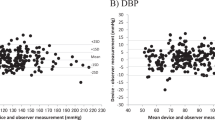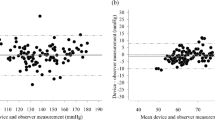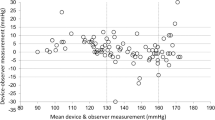Abstract
Few studies have been conducted on blood pressure monitors and their use at high altitude. This study is the first to evaluate the accuracy of an automatic blood pressure monitor in a high-altitude environment following a standard validation protocol. The Omron HEM-7201 upper arm blood pressure monitor was tested for accuracy in Lhasa, Tibet, China (3650 m above sea level) according to the European Society of Hypertension International Protocol revision 2010 (ESH-IP2). Thirty-three participants received 9–10 sequential blood pressure measurements alternating between a mercury sphygmomanometer and the device. The mean device-observer measurement difference was 1.0±5.9 mm Hg for systolic blood pressure (SBP) and −3.1±4.6 mm Hg for diastolic blood pressure (DBP). Of the 99 measurement pairs analyzed, 72, 90 and 97 device readings were within 5, 10 and 15 mm Hg, respectively, of the observer measurements for SBP, and 68, 92 and 99 readings for DBP. The number of participants with at least two out of three measurements within 5 mm Hg was 27 for SBP and 25 for DBP. Three participants had no measurements within 5 mm Hg for either SBP or DBP. As a result, the Omron HEM-7201 passes the ESH-IP2 validation criteria and can therefore be recommended for use in adults in this setting.
This is a preview of subscription content, access via your institution
Access options
Subscribe to this journal
Receive 12 digital issues and online access to articles
$119.00 per year
only $9.92 per issue
Buy this article
- Purchase on Springer Link
- Instant access to full article PDF
Prices may be subject to local taxes which are calculated during checkout



Similar content being viewed by others
References
O’Brien E, Asmar R, Beilin L, Imai Y, Mallion JM, Mancia G et al. European Society of Hypertension recommendations for conventional ambulatory and home blood pressure measurement. J Hypertens 2003; 21 (5): 821–848.
Perloff D, Grim C, Flack J, Frohlich ED, Hill M, McDonald M et al. Human blood pressure determination by sphygmomanometry. Circulation 1993; 88: 2460–2470.
Skirton H, Chamberlain W, Lawson C, Ryan H, Young E . A systematic review of variability and reliability of manual and automated blood pressure readings. J Clin Nurs 2011; 20: 602–614.
Parati G, Faini A, Castiglioni P . Accuracy of blood pressure measurement: sphygmomanometer calibration and beyond. J Hypertens 2006; 24 (10): 1915–1918.
Mercury-free Health Care [Internet]. Argentina: Health Care Without Harm and the World Health Organization; 2012. Available at http://www.mercuryfreehealthcare.org/.
Mengden T, Asmar R, Kandra A, Di Giovanni R, Brudi P, Parati G . Use of automated blood pressure measurements in clinical trials and registration studies: data from the VALTOP Study. Blood Press Monit 2010; 15: 188–194.
O’Niell H, O’Brien E, Stanton A, Hedditch K . The suitability of an automated blood pressure measuring device—the Omron HEM-705CP—in a large multicentre study: the ASCOT study. J Hum Hypertens 2001; 15 (Suppl 1): S83–S85.
Verberk WJ, Kroon AA, Kessels A, de Leeuw PW . Home blood pressure measurement: a systematic review. J Am Coll Cardiol 2005; 46: 743–751.
American National Standard. Non-invasive sphygmomanometers part 2: clinical validation of automated measurement type. ANSI/AAMI/ISO 81060-2:2009. Association for the Advancement of Medical Instrumentation (AAMI): Arlington, VA, 2009.
O’Brien E, Petrie J, Littler W, de Swiet M, Padfield PL, Altman DG et al. The British Hypertension Society protocol for the evaluation of blood pressure measuring devices. J Hypertens 1993; 11 (Suppl 2): S43–S62.
O’Brien E, Pickering T, Asmar R, Myers M, Parati G, Staessen J et al. International protocol for validation of blood pressure measuring devices in adults. Blood Press Monit 2002; 7: 3–17.
O’Brien E, Atkins N, Stergiou G, Karpettas N, Parati G, Asmar R et al. European Society of Hypertension International Protocol revision 2010 for the validation of blood pressure measuring devices in adults. Blood Press Monit 2010; 15 (1): 23–38.
Topouchian J, Agnoletti D, Blacher J, Youssef A, Ibanez I, Khabouth J et al. Validation of four automatic devices for self-measurement of blood pressure according to the international protocol of the European Society of Hypertension. Vasc Health Risk Manage 2011; 7: 709–717.
Yi J, Wan Y, Pan F, Yu X, Zhao H, Shang F et al. Validation of the Medipro MediCare 100f upper arm blood pressure monitor, for self-measurement, according to the European Society of Hypertension International Protocol revision 2010. Blood Press Monit 2011; 16: 197–199.
Erdem E, Aydogdu T, Akpolat T . Validation of the Medisana MTP Plus upper arm blood pressure monitor, for self-measurement, according to the European Society of Hypertension International Protocol revision 2010. Blood Press Monit 2011; 16: 43–46.
Grim CE, Grim CM . The HoMedics BPA-200 and BPA-300 home blood pressure devices fail the European Society of Hypertension International Protocol and cannot be recommended for patient use. Blood Press Monit 2008; 13 (4): 227–229.
O’Brien E, Atkins N, Murphy A, Lyons S . Validation of the ROSSMAX blood pressure measuring monitor according to the European Society of Hypertension International Protocol for validation of blood pressure measuring devices in adults. Blood Press Monit 2003; 8: 261–265.
O’Brien E, Waeber B, Parati G, Staessen J, Myers MG . Blood pressure measuring devices: recommendations of the European Society of Hypertension. BMJ 2001; 322 (7285): 531–536.
Stergiou GS, Karpettas N, Atkins N, O’Brien E . Impact of applying the more stringent validation criteria of the revised European Society of Hypertension International Protocol 2010 on earlier validation studies. Blood Press Monit 2011; 16 (2): 67–73.
Moore LG . Human genetic adaptation to high altitude. High Alt Med Biol 2001; 2 (2): 257–279.
Kametas NA, McAuliffe F, Krampl E, Nicolaides KH, Shennan AH . Can aneroid sphygmomanometers be used at altitude? J Hum Hypertens 2006; 20 (7): 517–522.
Li S, Zhao X, Ba S, He F, Lam CT, Ke L et al. Can electronic sphygmomanometers be used for measurement of blood pressure at high altitudes? Blood Press Monit 2012; 17: 62–68.
Friedman BA, Alpert BS, Osborn D, Prisant LM, Quinn DE, Seller J . Assessment of the validation of blood pressure monitors: a statistical reappraisal. Blood Press Monit 2008; 13 (4): 187–191.
Acknowledgements
We thank Pu Chi for her invaluable assistance during the recruitment process and our Tibetan collaborators, Liu Zhong and Dang Zeng Dun Zhu, for their local support. This study was supported by the US National Heart, Lung and Blood Institute (National Institutes of Health) (Contract No. HHSN268200900027C) and the UnitedHealth Group Chronic Disease Initiative.
Author information
Authors and Affiliations
Corresponding author
Ethics declarations
Competing interests
The authors declare no conflict of interest.
Rights and permissions
About this article
Cite this article
Cho, K., Tian, M., Lan, Y. et al. Validation of the Omron HEM-7201 upper arm blood pressure monitor, for self-measurement in a high-altitude environment, according to the European Society of Hypertension International Protocol revision 2010. J Hum Hypertens 27, 487–491 (2013). https://doi.org/10.1038/jhh.2013.4
Received:
Revised:
Accepted:
Published:
Issue Date:
DOI: https://doi.org/10.1038/jhh.2013.4
Keywords
This article is cited by
-
Coverage and effectiveness of hypertension screening in different altitudes of Tibet autonomous region
BMC Public Health (2021)
-
Blood pressure and hypertension in people living at high altitude in Nepal
Hypertension Research (2019)
-
Prevalence and risk factors associated with hyperuricemia among working population at high altitudes: a cross-sectional study in Western China
Clinical Rheumatology (2019)
-
A new, short-recorded photoplethysmogram dataset for blood pressure monitoring in China
Scientific Data (2018)
-
Prevalence and risk factors associated with hypertension and prehypertension in a working population at high altitude in China: a cross-sectional study
Environmental Health and Preventive Medicine (2017)



